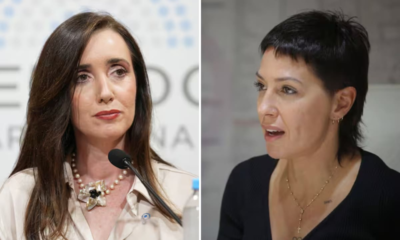INTERNACIONAL
Netanyahu responds after Israeli hostage seen emaciated, digging grave: ‘Cruelty of Hamas has no boundaries’
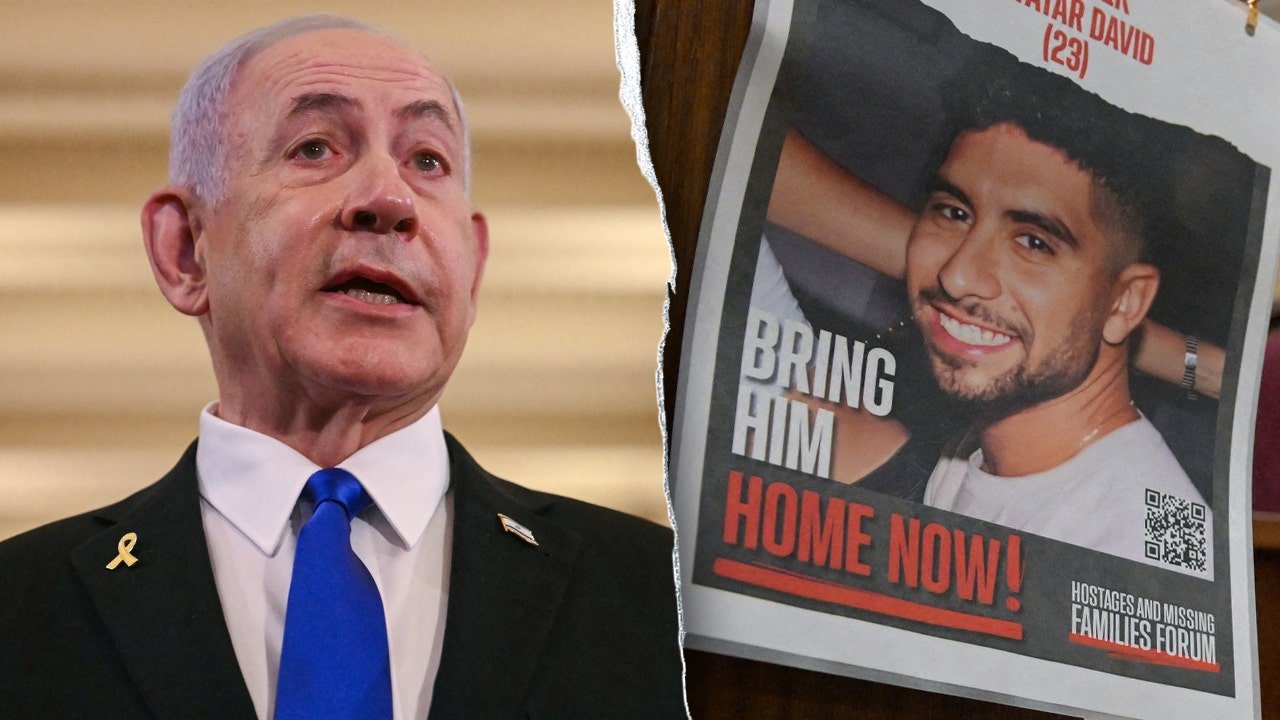
NEWYou can now listen to Fox News articles!
Israeli Prime Minister Benjamin Netanyahu has responded to a disturbing new Hamas propaganda video showing 24-year-old Israeli hostage Evyatar David severely emaciated and digging what he said was his own grave.
«The cruelty of Hamas has no boundaries,» Netanyahu said in a statement. «While the State of Israel is allowing the entry of humanitarian aid to the residents of Gaza, the terrorists of Hamas are deliberately starving our hostages and document them in a cynical and evil manner.»
«The entire world must take a stand in a clear message against the criminal Nazi abuse perpetrated by the Hamas terror organization,» Netanyahu added.
The office of the Israeli prime minister said Saturday that Netanyahu had spoken «at length» with the families of David and another hostage, Rom Braslavski, who was recently seen in similar condition. Netanyahu «expressed profound shock over the materials distributed by the terror organizations Hamas and Palestinian Islamic Jihad.» According to his office, the prime minister told the families «that the efforts to return all our hostages are ongoing, and will continue constantly and relentlessly.»
FREED AMERICAN-ISRAELI HOSTAGE DETAILS STARVATION AND ABUSE BY HAMAS AS FAMILIES PUSH TRUMP FOR DEAL
Evyatar David’s brother spoke in Hostages Square in Tel Aviv on Aug. 2, 2025. (Getty Images)
His office said Netanyahu also «conveyed, in his wife Sara’s name, a great embrace to the families, telling them that she is heartbroken over the unbearable videos.»
In one video released by the terror group and made public Friday, a shirtless David is seen crossing off dates on a calendar and digging the grave in a tunnel barely as tall as he is.
In a statement released through the Hostages Families Forum Headquarters, David’s family said they were forced to watch their beloved son and brother «deliberately and cynically starved in Hamas’s tunnels in Gaza – a living skeleton, buried alive.»
«The deliberate starvation of our son as part of a propaganda campaign is one of the most horrifying acts the world has seen,» the family said.
David’s brother, Ilay, spoke at a massive rally demanding a ceasefire and hostage release deal in Tel Aviv over the weekend.
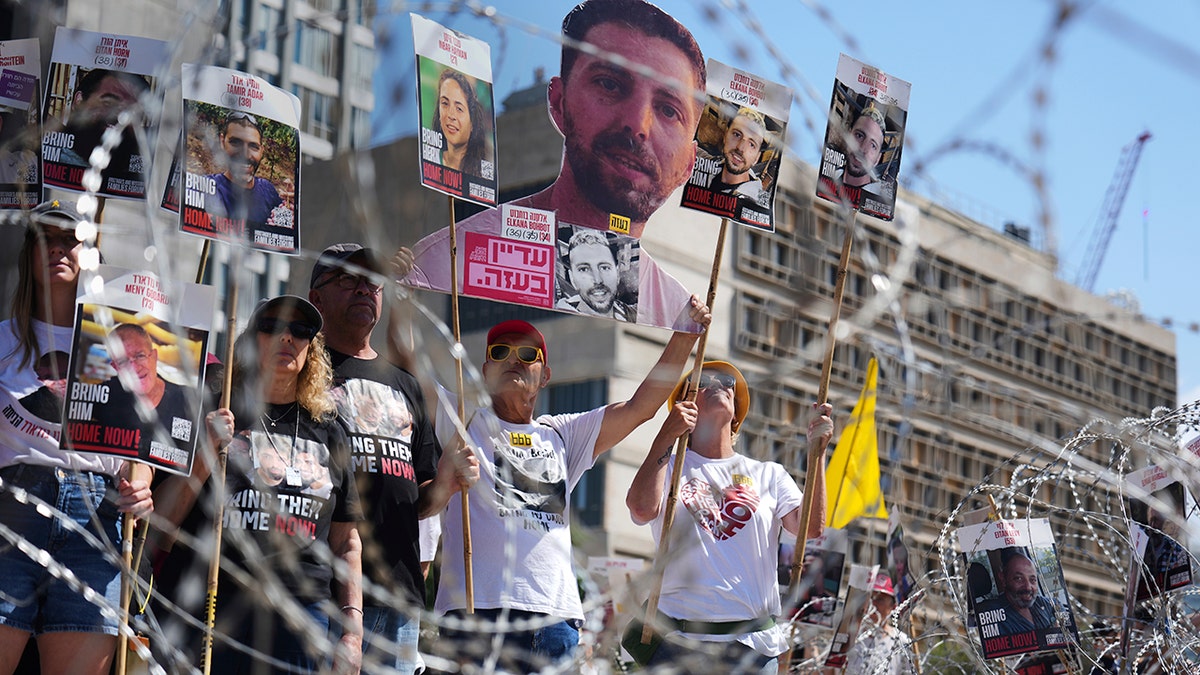
Families of hostages protest at the plaza known as the Hostages Square in Tel Aviv, Israel, Saturday, Aug. 2, 2025. (AP Photo/Ariel Schalit)
TRUMP BOASTS HE ‘STOPPED ABOUT FIVE WARS’ WHILE OPENING NEW SCOTLAND GOLF COURSE, VOWS TO WORK WITH NETANYAHU
«They are on the absolute brink of death. In their current, unimaginable condition, they may have only days left to live,» Ilay told the crowd in Hostages Square. «Hamas is using Evyatar in one of the most horrific and calculated campaigns of cruelty imaginable. A live hunger experiment. They are starving him deliberately, systematically, using his agonizing suffering as a twisted tool for depraved propaganda.»
«This is not just a violation of international law,» he said. «It is a brutal, barbaric assault on every shred of basic human decency. It’s an act so vile it scars the very soul of humanity.»
The U.S. and Israel pulled their negotiators from Doha, Qatar, two weeks ago as ceasefire and hostage-release talks with Hamas reached a standstill.
On Friday, U.S. Ambassador to Israel Mike Huckabee and Special Envoy to the Middle East Steve Witkoff met with Netayahu in Israel before spending several hours in Gaza inspecting food distribution centers amid hunger concerns.
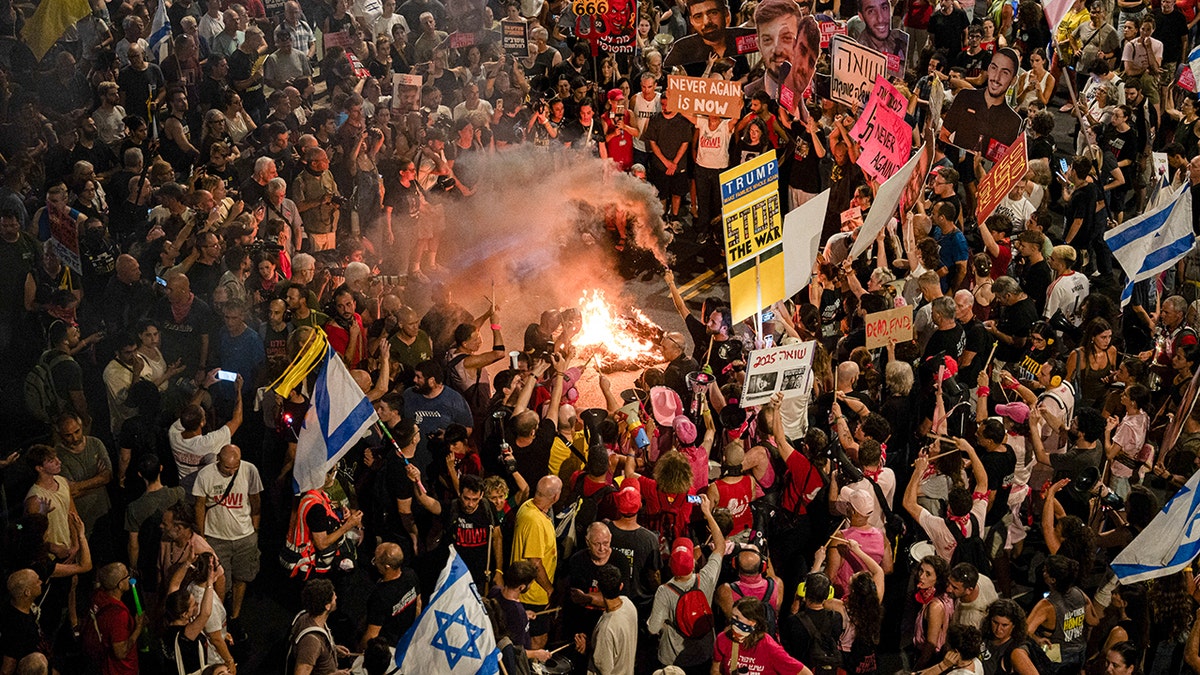
Families of hostages gather in Tel Aviv, Israel, on Aug. 2, 2025. (ORI AVIRAM/Middle East Images/AFP via Getty Images)
Witkoff said they spent over five hours inside Gaza – «level-setting the facts on the ground, assessing conditions,» and meeting with the Gaza Humanitarian Foundation and other agencies.
He said the purpose of the visit was to give President Donald Trump «a clear understanding of the humanitarian situation and help craft a plan to deliver food and medical aid to the people of Gaza.»
CLICK HERE TO GET THE FOX NEWS APP
Chapin Fay, a spokesperson for the Gaza Humanitarian Foundation, said the visit reflected Trump’s understanding of the stakes and that «feeding civilians, not Hamas, must be the priority.»
Fox News’ Yael Kuriel and the Associated Press contributed to this report.
conflicts,israel,benjamin netanyahu,middle east,terrorism
INTERNACIONAL
Unity tested: Democrats face off over Israel-Hamas war in Gaza, dark money in politics, during DNC summer meeting
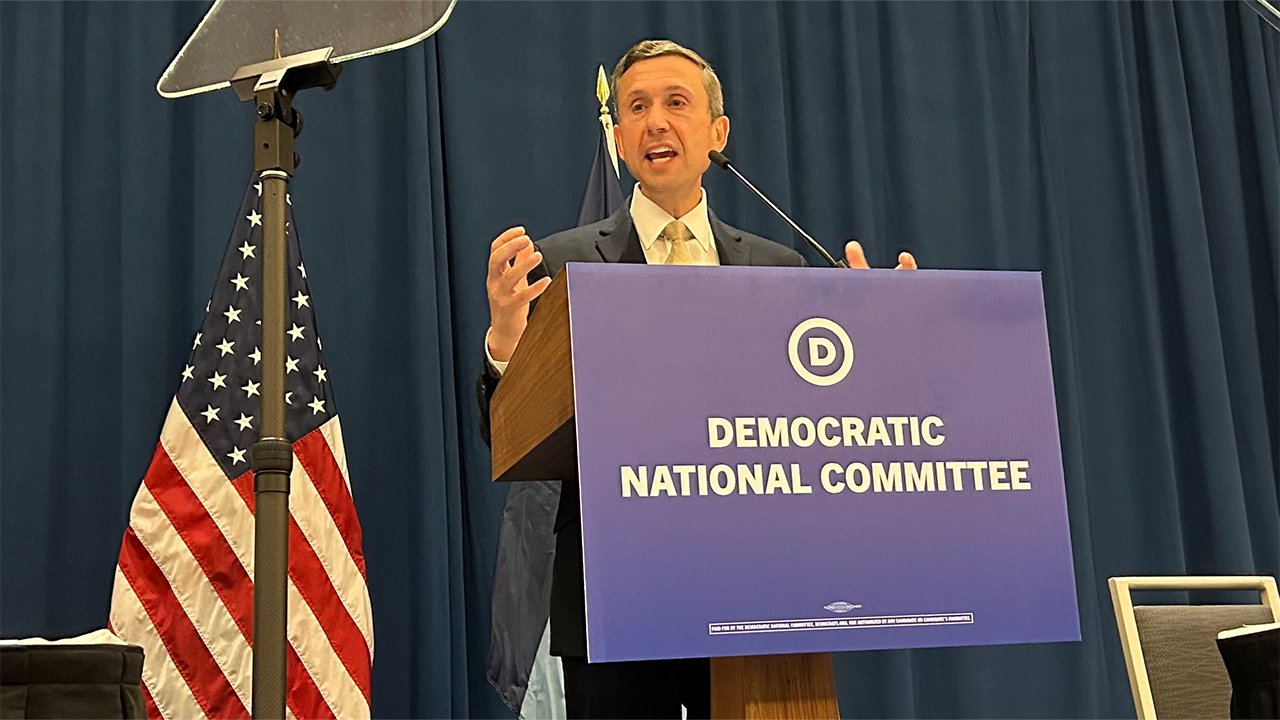
NEWYou can now listen to Fox News articles!
MINNEAPOLIS – Democrats opened their summer meeting in Minnesota on Monday with calls for unity against President Donald Trump, even as internal divisions on a host of issues threaten to erupt.
«We are unified towards one single goal: to stop Donald Trump and put this country back on track,» DNC Chair Ken Martin declared when he addressed the more than 400 elected party officials from all 50 states and seven territories, as the summer meeting kicked off in his home state of Minnesota.
While Democrats appeared united in their drive to counter the sweeping and controversial moves by Trump during his first seven months back in the White House, divisions among the committee members may flare on Tuesday.
DNC CHAIR DEMANDS DEMOCRATS ‘STOP BRINGING A PENCIL TO A KNIFE FIGHT’
Democratic National Committee Chair Ken Martin addresses party members at the DNC’s summer meeting on Aug. 25, 2025, in Minneapolis, Minnesota. (Paul Steinhauser – Fox News )
That’s when the war in Gaza between Israel and Hamas, and limiting dark money in presidential politics, will both be in the spotlight as the DNC’s Resolutions Committee meets.
Competing symbolic resolutions over the war in Gaza – which was sparked by the horrific Oct. 7, 2023, sneak attack by Hamas on Israel – will be voted on by the panel.
CLICK HERE FOR THE LATEST FOX NEWS REPORTING ON THE ISRAEL-HAMAS WAR
Nearly 1,200 people in Israel were killed during the initial surprise attack by Hamas, with over 250 people taken hostage. In the nearly two years since the attack, over 60,000 Palestinians have been killed in Israel’s ongoing military response.
The showdown over the resolutions comes as the Democratic Party’s once nearly unshakable support for Israel has fractured amid the bloodshed. And concerns over the growing death toll among Palestinians by many in the party’s progressive base have soared this spring and summer, amid famine in Gaza.

Residents in Gaza line up for food amid worsening famine on July 23, 2025. (Khames Alrefi/Anadolu via Getty Images)
Recent polling indicates support for Israel’s continued military actions in Gaza is plummeting among Democrats.
One resolution, which is supported by Martin, calls for a cease-fire between Israel and Hamas.
The competing resolution calls for an arms embargo and suspension of U.S. military aid to Israel, which has long been the top American ally in the Middle East.
The other resolution that’s bound to generate spirited debate and grab headlines on Tuesday is Martin’s push for the DNC to affirm its commitment to «eliminating unlimited corporate and dark money in our presidential nominating process beginning in the current 2028 cycle.»
While Democrats have long railed against the role of big money in politics, the resolution, which was first reported by the New York Times, calls for the creation of a new panel to propose by next summer «real, enforceable steps the D.N.C. can take to eliminate unlimited corporate and dark money in its 2028 presidential primary process.»
Outside groups such as super PACs, which are allowed to haul in unlimited contributions but are mandated to disclose their donors, have seen their influence in campaign politics multiply in recent election cycles.
DNC CHAIR TELLS FOX NEWS PARTY HAS HIT ‘ROCK BOTTOM’
Democratic leaders and officials are gathering as the party tries to escape the political wilderness after last year’s elections, when Democrats lost control of the White House and Senate and fell short in their bid to win back the House majority. And Republicans made gains in voter demographics that previously made up key parts of the Democratic Party’s base.
The situation has only worsened for Democrats in the 10 months since last year’s election setbacks.
The Democrats’ brand is deeply unpopular, especially with younger voters, as the party’s poll numbers continue to drop to all-time lows in national surveys.
The DNC faces a massive fundraising deficit at the hands of the rival Republican National Committee (RNC) and voter data indicated Democratic Party registration was plunging while GOP sign-ups were on the rise in the 30 states that register voters by party.
AMID PLUNGING POLLS, ANEMIC FUNDRAISING, DEMOCRATS LOOK TO REBOUND AT PARTY’S SUMMER MEETING
On Monday, amid talk that Democrats remain divided over a slew of policy and political issue, Martin wasn’t the only one preaching unity and downplaying any discord.
Minnesota Gov. Tim Walz, in an address to the committee members, said «there’s a division in my damn house, and we’re still married, and things are good. That’s life… We are strong because we challenge each other.»
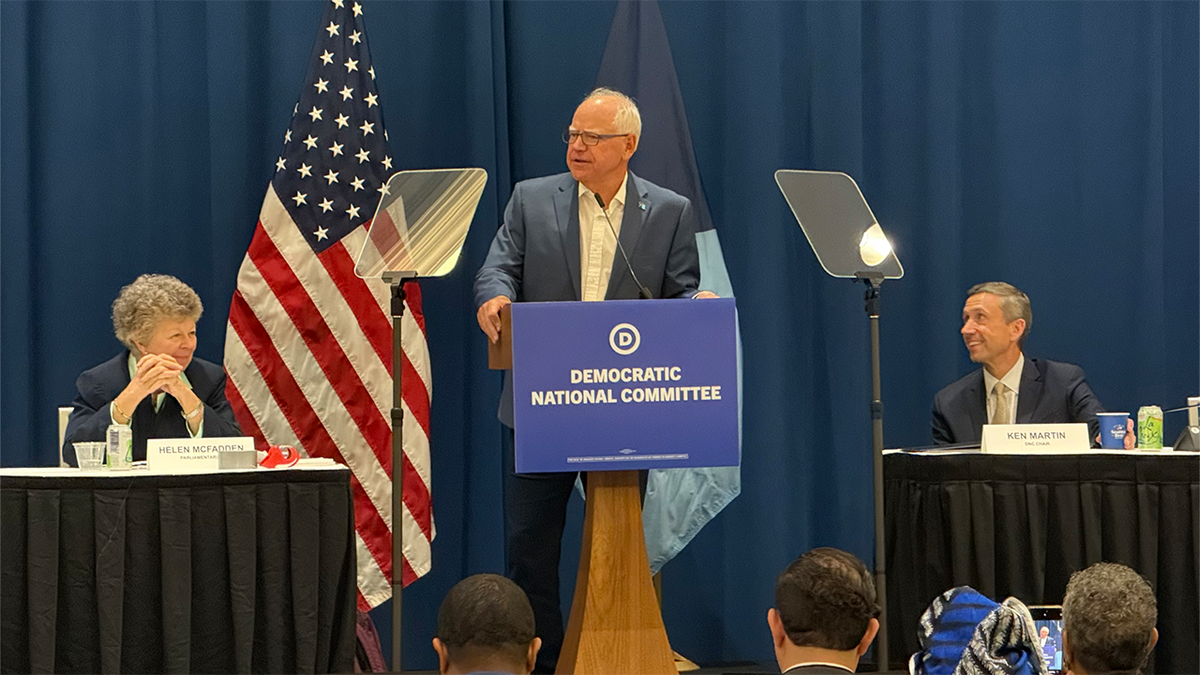
Minnesota Gov. Tim Walz speaks at the Democratic National Committee’s summer meeting, on Aug. 25, 2025 in Minneapolis, Minnesota. (Paul Steinhauser – Fox News)
And longtime Democratic strategist and DNC committee member Maria Cardona told Fox News, «I’m so sick of people focusing on the infighting and the circular firing squad. All of that is crap, when we have real issues, existential threats that we need to fight about, and we are all united on that front and that’s all that matters.»
Martin, who was elected DNC chair in February, has weathered turmoil during his tenure so far, including a controversy sparked by now-former vice chair David Hogg’s backing of primary challengers against older House Democrats in safe blue districts.
CLICK HERE TO GET THE FOX NEWS APP
RNC communications director Zach Parkinson, responding to Monday’s DNC session, told Fox News that «under Ken Martin’s leadership, Democrats have sunk to their lowest approval rating in 35 years.»
Pointing to Martin, Parkinson said «as Republicans, we think he is doing a fantastic job, and we fully endorse him to stay on as DNC Chair.»
democratic party,republicans elections,midterm elections,democrats elections,elections,politics,middle east foreign policy,israel
INTERNACIONAL
Madre Teresa de Calcuta: su canonización en tiempo récord y la historia del hombre que luchó para impedirla
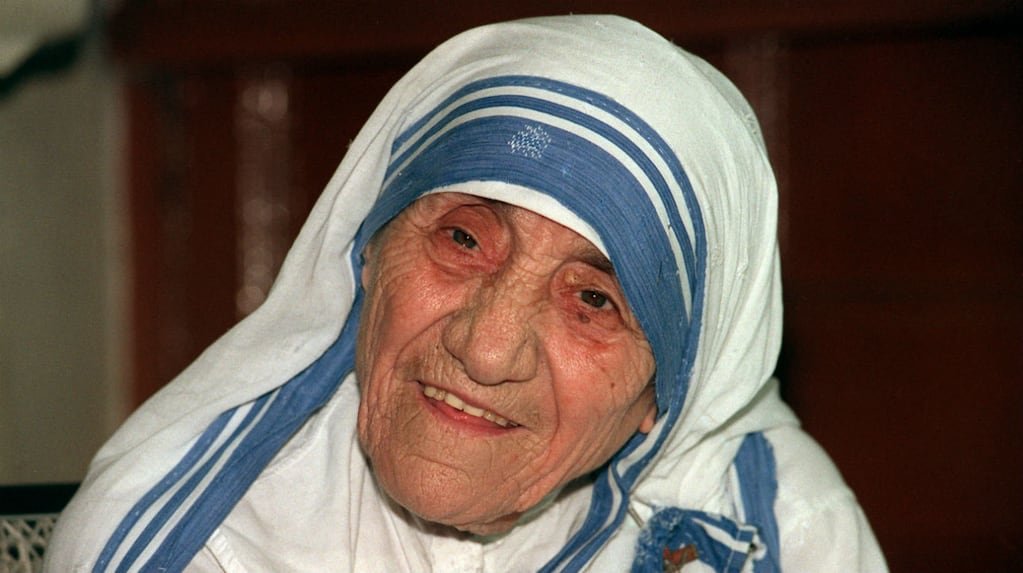
La Madre Teresa de Calcuta es la única persona que fue nombrada santa y, al mismo tiempo, ganó un Premio Nobel.
Eso no obstó a que tuviera detractores, enemigos que la criticaron con dureza. El principal, su propio abogado del diablo, fue el inglés Christopher Hitchens que atacó sus métodos y su misión.
Leé también: El secuestro que estremeció al país: los 372 días de horror en un pozo y una muerte que sigue impune
En las últimas tres décadas del Siglo XX fue una de las figuras religiosas, de los líderes espirituales, más conocidos del planeta junto a Juan Pablo II, el Dalai Lama y posiblemente algún telepredicador como Billy Graham.
La gran irrupción global de Santa Teresa de Calcuta, o la Madre Teresa, ocurrió en 1969, mientras los Beatles grababan sus últimos temas y el hombre llegaba a la Luna. El periodista de la BBC, Malcolm Muggeridge realizó Something Beautiful For God, un documental sobre la religiosa. Una película hagiográfica, que difundió su imagen por primera vez fuera de la India. Era, claro, una gran historia. A partir del documental, la figura pública de Teresa iría creciendo hasta convertirse en un símbolo mundial, con su hábito blanco con vivos, azules, sus movimientos lentos y su voz algo grave, no tan frágil como su figura, esa voz con la que opinaba de los asuntos del mundo, y los ojos vivaces, alertas.
La Madre Teresa de Calcuta en 1988 en Johannesburg. (Foto: Walter DHLADHLA / AFP)
Las donaciones comenzaron a llegar de manera cotidiana. Teresa decidió abrir nuevos centros de cuidado y hospitales y expandir su comunidad por el mundo.
Después llegó el Nobel, las revistas, Lady Di, el Papa, los Duvalier. Una especie de rockstar de la solidaridad con movimientos leves, menguados.
Tras su aparente fragilidad era enérgica para tomar decisiones y para disciplinar a las religiosas de su congregación, y muy convincente para pedir colaboraciones para su obra: muchos poderosos, acostumbrados a lidiar con negociaciones complicadas y arduas, terminaban la reunión con ella habiendo entregado mucho más de lo que estaban dispuestos a dar a su llegada.
Fue casi hasta sus 35 años una monja más de Calcuta, de esas que hacían sus ejercicios espirituales, trataban de respetar los votos de obediencia, castidad y pobreza (este último nada difícil de cumplir en Calcuta), de esas que daban clases en colegios secundarios; en su caso las materias eran historia y geografía. Todo cambió con la Hambruna de 1943 en Bengala. Allí vio lo que nunca había imaginado siquiera que podía existir. El hambre mató a más de un millón y medio de personas. Los cuerpos de los chicos desnutridos quedaban tirados por las calles, se apilaban en las esquinas. Poco después, en un viaje en tren, dijo haber tenido una revelación, una conversación divina, una charla con el mismísimo Jesús en la que la conminaba a tomar cartas en el asunto, a dedicarse a los más pobres. Dejar el convento y acercarse a los que sufrían.
De Agnes a Teresa, en homenaje a la patrona de los misioneros
Había nacido el 26 de agosto de 1910, como Anjeze (Agnes) Ghonxhe Bojaxhiu en Uskub, ciudad del Imperio Otomano (hoy Skopie, capital de Macedonia del Norte). Su familia era de origen albanés. Su padre, un comerciante de buen pasar económico. Cuando el hombre murió, a los 8 años de Agnes, todo cambió. La familia empezó a pasar necesidades y la chica ingresó a vivir con las monjas de Loreto. A los 18 años ingresó al noviciado. Poco después fue enviada a la India, a la ciudad de Calcuta. Cambió su nombre en homenaje a Teresa de Lisieux, la santa patrona de los misioneros.
Después de la hambruna del 43 salió del convento, dejó las aulas y recorrió las calles. En las peores zonas de la ciudad brindó su ayuda y consuelo. Y se dispuso a convivir con los pobres.
Leé también: Día Nacional de la Solidaridad: el trabajo incansable de la madre Teresa de Calcuta
Teresa quiso formar su propia congregación pero eso no es tan sencillo en la estructura jerárquica de la Iglesia. Tardó dos años en conseguir que el obispo la dispensara de sus votos y que le permitiera la creación de las Misioneras de la Caridad. El lema que se impuso fue: “Amar y cuidar a aquellas personas que nadie estaba preparado para cuidar”.
A partir de ese momento se dedicó a Los Intocables, la clase más baja y olvidada de la India. Al cuidado de los enfermos (en esos primeros años en especial a los leprosos), a acompañar a los moribundos, los chicos huérfanos, los hambrientos. Sostenía que su objetivo no eran los pobres, sino “los más pobres entre los pobres”. Creó escuelas, hospicios, hospitales, orfanatos.
La Madre Teresa dijo: “Nuestra misión era cuidar a los hambrientos, los desnudos, los indigentes, los discapacitados, los ciegos, los leprosos, todas esas personas que se sienten indeseadas, no amadas, abandonadas por toda la sociedad, aquellas que se han convertido en una carga para la sociedad y son apartadas por todos”. Tras su aparente fragilidad era enérgica para tomar decisiones y para disciplinar a las religiosas de su congregación. (Foto: TEKEE TANWAR / AFP)
La actual corresponsal de CNN en Hong Kong se crió en Calcuta. Su madre era voluntaria de las obras de Teresa. “Ella solía estar ahí. Tan simple como eso. La veías acunando a un bebé enfermo, dándole de comer a un chico, o jugando con él mientras tironeaban de su hábito blanco. Era de tamaño pequeño pero con una energía descomunal, caminando con pasos rápidos de una instalación a otra. Siempre hacía contacto visual cuando te hablaba. Su mirada era muy intensa. Tenía una presencia tremenda”, escribió la periodista que dice que nunca pensó que iba a conocer a una santa.
Su congregación no dejó de crecer. En un principio pareció que su tarea sería de alcance limitado, que no tendría mayor repercusión. Estaba trabajando en un país enorme, súperpoblado, en el que sólo el 2.3% de la población era católica; ella representaba a una religión muy minoritaria en India. Llegó a tener 6000 religiosas y a establecerse en más de cien países.
Cuando en 1979 le concedieron el Premio Nobel de la Paz su masividad se terminó de consolidar. Su obra no paraba de expandirse y de recibir donaciones. Mostró la cara oscura de su ciudad adoptiva, de Calcuta, y también de la India, pero al mismo tiempo logró concientizar de las necesidades que pasaba la gente y de la urgencia de hacer algo.
Muchas celebridades se solidarizaron y colaboraron con su causa; también lo hicieron algunos infames, delincuentes y hasta dictadores como los Duvalier de Haiti.
Su lugar en la conversación pública y su influencia fueron tan importantes, que su intervención, su solo involucramiento consiguió logros que le fueron negados a batallones de diplomáticos o legiones de lobistas. Consiguió una tregua en Beirut para poder sacar un nutrido grupo de huérfanos de la zona de conflicto, logró que en Estados Unidos liberen a presidiarios con HIV avanzado, que estaban muriendo, y, también, que distintos gobiernos alrededor del mundo presten mayor atención a su población más excluida. Brindaba ayuda humanitaria cuando en algún lugar, por más remoto que fuera, ocurría una catástrofe natural de dimensiones, u organizaban asistencia para refugiados.
Años después de su muerte, cuando se conocieron sus cartas y sus escritos privados, se supo que la vida espiritual, su vida como religiosa, fue un camino escarpado para ella, que debió soportar quiebres en su voluntad, dudas y por momentos que la fe la abandonara. Contó que esas tribulaciones la acompañaron durante 50 años.
Durante un largo tiempo la opinión favorable hacia ella, las religiosas de su comunidad y la obra que encaraban fue unánime. Pero de a poco empezaron a aparecer críticas. Su perseguidor más pertinaz y agudo parece haber sido Christopher Hitchens, el implacable pensador inglés.

El escritor Christopher Hitchens, uno de los grandes detractores de la Madre Teresa. (Foto: Amanda Edwards/Getty Images / via AFP)
En su libro -nada condescendiente, demoledor- The Missionary Position: Mother Teresa in Theory and Practice (un juego de palabra con referencias sexuales por lo de la Posición del Misionero), Hitchens pinta a Teresa como una oportunista con gran habilidad, que utiliza la situación de pobreza extrema de buenas partes de la India en beneficio propio, para engrosar las arcas de su congregación y para obtener fama y poder. Para Hitchens, Teresa “no era amiga de los pobres, sino una entusiasta de la pobreza”.
Le endilgaba que en vez de luchar contra la pobreza era una promotora de la pobreza y que había un regodeo en el sufrimiento. La religiosa respondía que ella enfrentaba la pobreza y acompañaba a los que la padecían. Y que el sufrimiento era una manera de acercarse a Dios.
Sus defensores dicen que Teresa de Calcuta vivió pobre entre los pobres y que nada más que los que viven entre pobres, en la pobreza absoluta, pueden entender la lógica de la ayuda que ella brindaba, muy diferente a la de los gobernantes que se mueven por intereses propios y a golpes de demagogia, y a lo de los periodistas que van en busca de alguna historia rutilante o escandalosa y después se retiran.
Otra imputación fue que parte del dinero se gastó en difundir las ideas cristianas en países pobres que tenían otras necesidades.
Leé también: Madre Teresa de Calcuta, la mujer que el Papa Francisco convirtió en santa
Teresa de Calcuta defendía a ultranza todos los dogmas de la iglesia y, por lo tanto, se oponía a los posibles aggiornamientos que normalizó la vida moderna. Entre ellos, su postura más férrea era contra el aborto. Tanto es así que mencionó la cuestión en su discurso de recepción del Premio Nobel. Habló de varios factores amenazaban la paz y recalcó: “Siento que el mayor destructor de la paz hoy es el aborto, porque es una guerra directa, un asesinato directo por parte de la madre misma”
Hitchens afirmaba que la religiosa rechazaba con vehemencia “la única política que ha aliviado la pobreza en todas las naciones, que es empoderar a las mujeres y asegurar su control sobre su propia fertilidad”.
Teresa estaba absolutamente en contra del divorcio. Hitchens escribió que esa postura condenaba a muchas mujeres al sufrimiento y que cuando Lady Di, amiga de Teresa, se divorció, ella modificó su postura.
El escritor inglés la describió como “una fundamentalista religiosa, activista, sermoneadora a la antigua y cómplice de los poderes políticos”.
Sus críticos le endilgaban que sus hospitales eran demasiado primitivos y que la atención médica era escasa. Las Misioneras de la Caridad sostenían que esa era la atención que podían brindarle y que de otra manera era gente que no hubiera tenido ningún tipo de asistencia, que hubieran muerto en la calle, sin nadie a su lado y sin tratamiento alguno. Muchos testimonios concuerdan en que las condiciones de sanidad no eran las mejores y que las monjas muchas veces reutilizaban agujas y que las sábanas manchadas con excrementos se lavaban en la misma habitación que los instrumentos quirúrgicos y los utensilios de cocina.
Otra imputación: que las religiosas intentaban convertir al cristianismo a los que eran atendidos, asistidos y curados por ellas. La respuesta de las religiosas fue contundente: nunca dejaron de acercarse a alguien por sus creencias religiosas, a nadie se le pidió certificado de bautismo para asistirlo.
Un par de años atrás la miniserie documental Madre Teresa: ¿Por amor a Dios?, como las últimas biografías, da espacio a los detractores e investiga las distintas críticas y hasta imputaciones que se le realizaron. También instala un nuevo tema. Cuenta que cuando el padre Donald McGuire fue acusado de decenas de casos de abusos contra niños, la Madre Teresa firmó una carta dirigida a las autoridades en la destacaba la confianza que ella tenía en McGuire. Lo cierto es que McGuire no fue desplazado y que luego se probó que siguió abusando de menores durante al menos 10 años más hasta que fue detenido.
El camino de Teresa de Calcuta a la santidad
Mientras vivía se hablaba de que se trataba de una santa. Se lo decía en el sentido popular del término, no en el eclesiástico. Pero el proceso para ingresar al santoral católico fue mucho más veloz que lo pensado.
El proceso para santificar a una persona es largo y complejo. El derecho canónico establece condiciones rígidas que el Papa Juan Pablo II decidió saltearse en virtud de la excepcionalidad del caso, de la cercanía que había mantenido con Teresa y de su inmensa popularidad y arraigo popular. El papa polaco la beatificó a los pocos años de su muerte, antes de que se cumpliera el plazo establecido. La Madre Teresa y el Papa Juan Pablo II en febrero de 1986, durante una visita en la India. (Foto: JEAN-CLAUDE DELMAS / AFP)
Para que alguien sea nombrado santo por el Vaticano es imprescindible que se asocie un hecho “milagroso” a las oraciones y pedidos hacia la persona en cuestión. Y se presume que esa persona intercedió y posibilitó, por ejemplo, la cura milagrosa, fuera de los cánones razonables o lógicos de curación, de alguien muy enfermo, casi desahuciado. Se le atribuyó la sanación de un brasileño con múltiples tumores cerebrales que se curó de manera inmediata.
El Vaticano inicia un largo trámite para verificar el milagro. Y reflotó un viejo instituto de estos procesos, El Abogado del Diablo, una especie de fiscal que está en contra del posible santa, que expone sus defectos, miserias, que descree de los milagros aludidos. En este proceso, la Iglesia -muy adecuadamente- nombró a Christopher Hitchens en ese rol.
La Madre Teresa de Calcuta siguió trabajando hasta el final. A principios de 1997 renunció a la dirección de las Misioneras de la Caridad. Estaba débil y enferma. Murió en Calcuta, el 5 de septiembre de ese año, cinco días después que Lady Di, una de las figuras públicas que se había acercado a ella. Tenía 87 años. Recibió un funeral de estado. India la despidió con el mismo ritual que le dedicó a Gandhi y a Nehru.
La Madre Teresa fue nombrada santa en tiempo récord, 19 años después de su muerte. La canonizó el Papa Francisco en 2016. A partir de ese momento fue Santa Teresa de Calcuta.
Teresa de Calcuta, religion, India
INTERNACIONAL
Trump battles John Bolton, Chris Christie and threatens to pull funds from Wes Moore’s Maryland
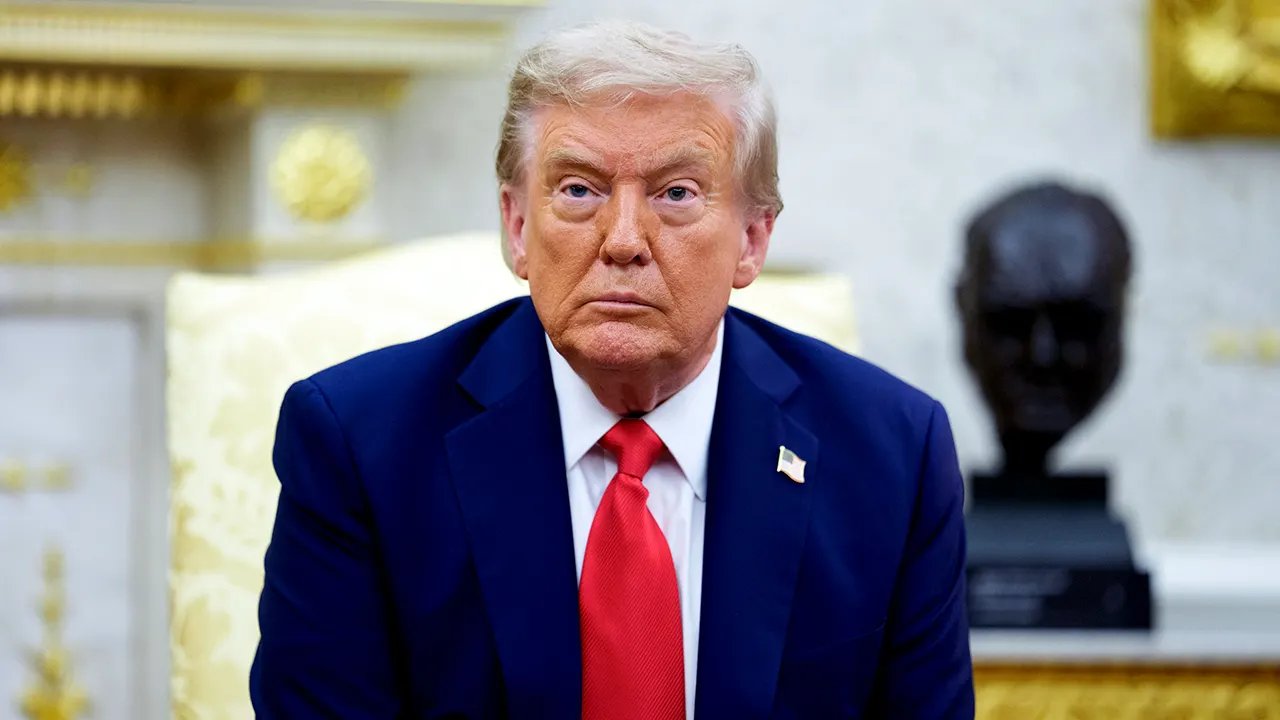
NEWYou can now listen to Fox News articles!
I asked Donald Trump the question. Everyone asked Donald Trump the question.
Would he engage in retribution in a second term?
And we all got the same answer: He’d be too busy for that. His only retribution would be success.
Well, if Trump is not engaged in turning government against his political enemies, he’s doing a pretty good imitation of it.
Now, hardball politics is as old as the republic. The founders engaged in it. Abe Lincoln engaged in it. And you think LBJ never got his way by threatening to pull a grant or two for a congressman’s pet projects?
Look, one thing I’ve learned covering Trump for decades is that he loves to fight. In New York, back in the day, he would do battle with the likes of Ed Koch and Leona Helmsley, the «Queen of Mean.»
BROADCAST BIAS: NETWORKS OOZE WITH SYMPATHY TO ANYONE WHO OPPOSES TRUMP
President Donald Trump has dismissed suggestions that he would target political enemies, but Trump’s combative approach reflects a pattern that has defined both his career and American politics more broadly. (Aaron Schwartz/CNP/Bloomberg via Getty Images)
When his divorce from Ivana became a tabloid sensation, Trump got on the phone with me to discuss why his proposed settlement was really generous.
We see that fighting instinct today when the president goes after not just Democrats but fellow Republicans who defy him, or won’t back his proposals – a number of whom have announced their retirements rather than lose a primary to a Trump-backed challenger.
We see that Trump-against-the-world approach with his crackdown on D.C. crime which, despite the home-rule issues, is being welcomed by some liberals (publicly and privately) because folks are scared in a city that can’t even stop teenage carjackings.
The next target is Chicago, which also has a Black mayor, with the Washington Post reporting that there has been weeks of secret planning to send thousands of National Guard troops there. Illinois Gov. J.B. Pritzker has denounced this as an effort to spread fear, and sometimes it seems like the president is at war with urban America.
The underlying motivation is crucial: Trump believes that the Democrats waged «lawfare» against him for four years. There is no evidence that President Biden ordered such efforts, but Trump is convinced that the multiple investigations against him–as in the Stormy Daniels case–were part of a grand scheme to knock him out of the race.
And he has a point. Look at the outrageously illegal fine that Judge Arthur Engoron hit him with in the civil fraud case brought by New York AG Letitia James: $354 million, since grown to $515 million.
This was so blatantly unfair that an appellate court just threw it out as a violation of the Eighth Amendment, barring cruel and unusual punishment. James is appealing, and the court didn’t toss the whole case–the «fake» case, says Trump–but a half-billion-fine over real estate valuations seems pathetically unfair.
But when Trump cried foul, the media reaction was there he goes again, attacking every judge who disagrees with him. But Trump was right about Engoron.
The Trump DOJ, by the way, is now investigating Tish James for allegations of mortgage fraud.
So what the press sees as Trump going after his opponents is, in his eyes, just basic payback, an attempt at getting even.
Having said that…
«I just watched Sloppy Chris Christie be interviewed on a ratings challenged ‘News’ Show…on ABC Fake News,» «This Week» hosted by George Stephanopoulos.
«Can anyone believe anything that Sloppy Chris says? Do you remember the way he lied about the dangerous and deadly closure of the George Washington Bridge in order to stay out of prison, at the same time sacrificing people who worked for him, including a young mother, who spent years trying to fight off the vicious charges against her. Chris refused to take responsibility for these criminal acts. For the sake of JUSTICE, perhaps we should start looking at that very serious situation again?»
Christie, a onetime ally, was Trump’s harshest Republican critic during the campaign. As for the 2013 scandal known as Bridgegate, it was thoroughly investigated and two top Christie aides were convicted, but the Supreme Court, while blasting the conduct, overturned those convictions.
It’s worth pointing out that the decision to close some lanes on the George Washington Bridge, which created traffic chaos, was the governor’s attempt to strike back at a Democratic mayor who refused to endorse him.
«Time for some traffic problems in Fort Lee,» wrote one of the convicted aides in a remarkably succinct message.
«I always thought he got away with murder,» Trump told reporters yesterday.
Having watched the Sunday shows, the president unloaded on two networks:
«Despite a very high popularity and, according to many, among the greatest 8 months in Presidential History, ABC & NBC FAKE NEWS, two of the worst and most biased networks in history, give me 97% BAD STORIES. IF THAT IS THE CASE, THEY ARE SIMPLY AN ARM OF THE DEMOCRAT PARTY AND SHOULD, ACCORDING TO MANY, HAVE THEIR LICENSES REVOKED BY THE FCC. I would be totally in favor of that because they are so biased and untruthful, an actual threat to our Democracy!!!»
CHRIS MATTHEWS SAYS DEMOCRATS ‘FALLING INTO A TRAP OF DEFENDING WHAT’S INDEFENSIBLE’ ON CRIME
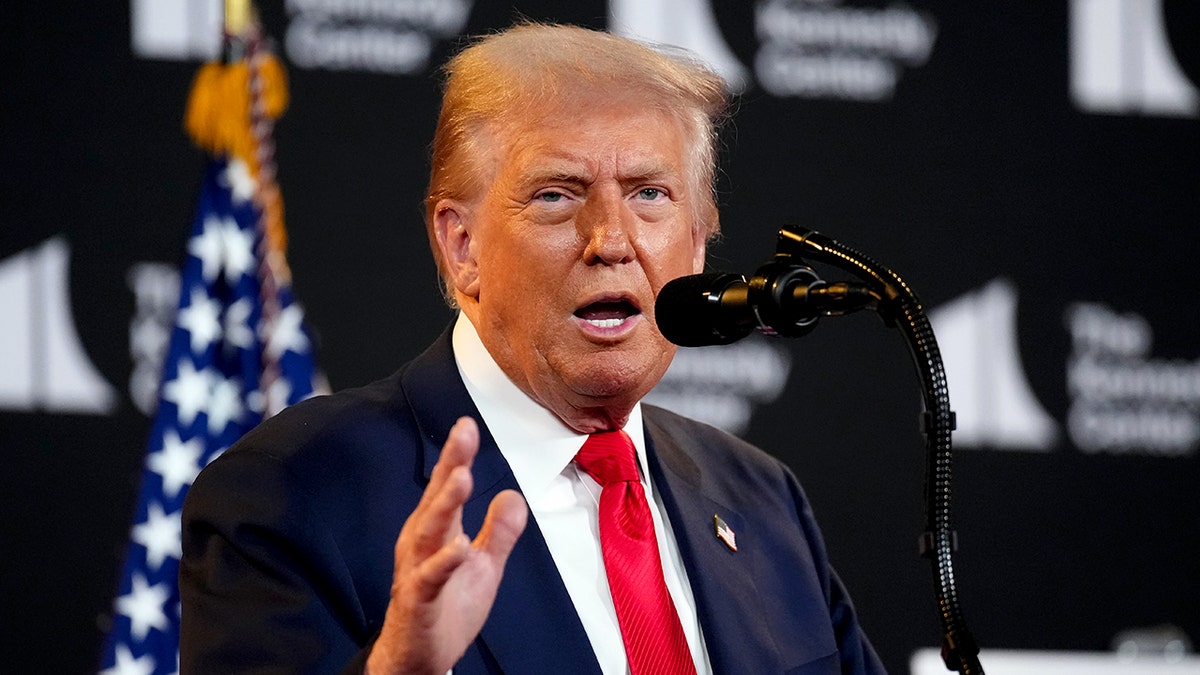
President Donald Trump and former national security adviser John Bolton have feuded since Trump fired him in 2019. (Photo by Andrew Harnik/Getty Images)
He added that ABC and NBC should be paying «Millions of Dollars a year in LICENSE FEES…Crooked ‘journalism’ should not be rewarded, it should be terminated!!!»
Now networks shouldn’t lose their licenses just because the president doesn’t like their coverage. Maybe they should be paying more for use of the airwaves, but that should apply to all networks; so far they’ve played by the rules.
Trump and John Bolton have been at each other’s throats since the president fired the national security adviser. There was a criminal investigation over Bolton’s 2020 book that Trump tried to stop, but it was cleared for publication.
I take Trump at his word that he didn’t know in advance about the FBI raid on Bolton’s Bethesda home. But twice in the days leading up to the raid, Trump was slamming him online for criticizing his efforts to end the Russia-Ukraine war..
«Very unfair media is at work on my meeting with Putin. Constantly quoting fired losers and really dumb people like John Bolton, who just said that, even though the meeting is on American soil, ‘Putin has already won.’ What’s that all about?»
After the raid, Trump called Bolton a «low-life» and a «sleazebag» who suffers from «major Trump Derangement Syndrome.»
But two things can be true at once. Trump prosecutors had to show convincing evidence to a special court to get the search warrant approved. So it’s possible that Bolton did hang on to some classified documents.
After the raid, Trump posted that Bolton was among the «stupid people» who were making it «much harder» for him to end the war by ripping his approach to Putin.
I’ve known John Bolton for years–he used to be a Fox contributor–and I’m surprised he’s made no comment. There was just a little wave at the press pack when he returned home.
Next up: Wes Moore, Maryland’s first Black governor.
They’ve been jabbing each other back and forth, which is fine. But then the president posted this:
«Governor Wes Moore of Maryland has asked, in a rather nasty and provocative tone, that I ‘walk the streets of Maryland’ with him. I assume he is talking about out of control, crime ridden, Baltimore? As President, I would much prefer that he clean up this Crime disaster before I go there for a ‘walk.’ Wes Moore’s record on Crime is a very bad one.».
DEMOCRATS’ NEW BOOGEYMAN IS A DIFFERENT KIND OF DONALD TRUMP

Governor Wes Moore of Maryland has been rebuilding the Francis Scott Key Bridge with funds approved by Congress as part of a package during the Biden Administration. (Photo by Chip Somodevilla/Getty Images)
There’s more:
Trump «offered» to deploy troops to Baltimore – which has a serious crime problem – after which he would accept Moore’s invitation to meet him on the streets.
Then came the threat: «I gave Wes Moore a lot of money to fix his demolished bridge. I will now have to rethink that decision???»
Moore has been rebuilding the Francis Scott Key Bridge since a reckless and out-of-control tanker destroyed it early last year. And for the record, Congress approved the funds as part of a package during the final stretch of the Biden administration.
But put that aside. Who would be hurt if Trump carried out this threat?
Millions of people in Maryland who rely on the bridge, or whose jobs are tied to commerce in that region.
So Trump is openly suggesting to use the official power of government to withhold funds that would hurt ordinary citizens. That is more troubling than the punching and counterpunching with Bolton and Christie.
For what it’s worth, I don’t think Trump would actually do it. It’s a brushback pitch.
CLICK HERE TO GET THE FOX NEWS APP
While Trump may view himself as evening the score, one day Democrats will occupy the White House again. They would feel fully justified in going after their opponents as payback for the way they were targeted for investigation. And the endless cycle continues.
media buzz,donald trump,republicans elections,feud

 DEPORTE3 días ago
DEPORTE3 días agoChile organizó una colecta para que la familia del hincha que fue operado por fractura de cráneo pueda viajar a la Argentina

 DEPORTE3 días ago
DEPORTE3 días agoEl fútbol chileno se solidarizó con la U tras los graves incidentes que se registraron ante Independiente

 POLITICA3 días ago
POLITICA3 días agoEl fuerte cruce entre Victoria Villarruel y Mayra Mendoza por el caso de los audios
























